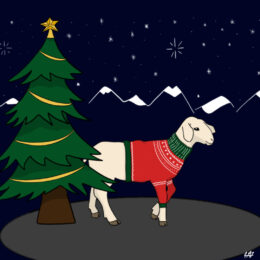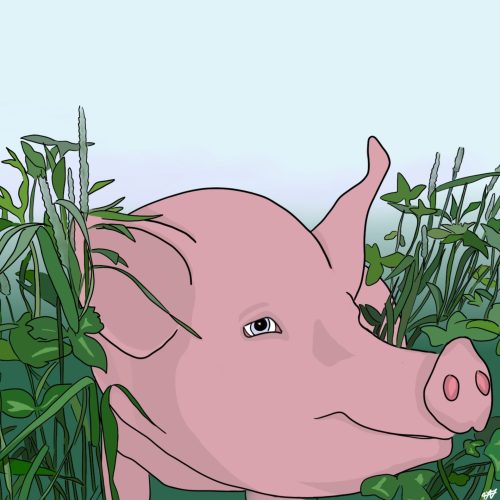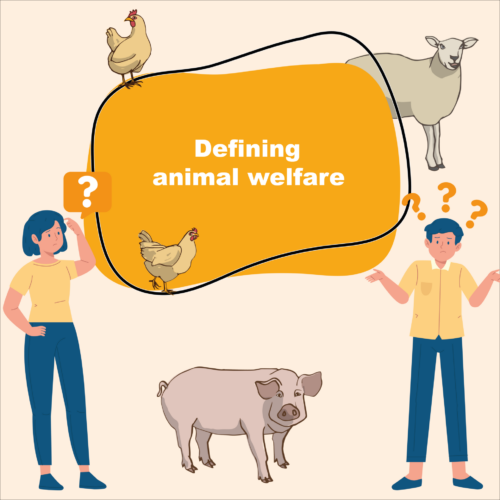

FALSE...
but it can be stressful!
KEEP IN MIND
- Shearing is not painful if carried out by a professional. It is even necessary for sheep as they do not shed wool naturally
- However, it requires immobilization which is generally a source of stress
- After shearing, precautions must be taken to keep sheep warm!
- Labels guarantee that wool comes from a farm that respects animal welfare
Winter is here, Christmas is approaching, and you are thinking of gifting this beautiful Merino wool sweater that you have spotted. But you may also be wondering about wool production and animal welfare.

Did you know?
Many animals produce wool, like goats, alpagas, rabbits and dogs... but we will mainly focus on sheep in this article
No pain...
Back to the basics, what is wool?
Wool is a fiber of animal origin, most often from sheep, goats or llamas, more precisely a particular type of hair produced by these species.
It is usually harvested using an electric trimmer, much like a beard or hair trimmer (but more powerful!).
In terms of pain, therefore, sheep shearing is similar to going to the hairdresser for humans: it is simply about cutting hair.
… but not without risks
However, shearing should not be done carelessly. It can injure the animal if it is not carried out by a professional. Blades from the clippers or the blade shears can cut the skin of the animal if they are badly positioned.
In fact, to avoid injuries, this operation requires the immobilization of the animal (restraint) and its isolation from the rest of the group, which are generally a source of stress[1] [2]. Shearing thus causes a stress peak that can be detected for as long as an hour through blood analysis of the various stress markers[3].
In the weeks following shearing, other measures must also be taken regarding the animal’s thermal comfort (see below) or bedding– which, on a hard floor, is facilitated by the presence of wool.
A great deal of research has gone into developing methods to minimize stress at the time of shearing and in the days that follow.

Did you know?
Providing suitable bedding for the animals the days following their shearing helps the sheep to recover more quickly [4]
Are they not cold afterwards?
As you would expect, a shorn animal is less resistant to low temperatures than an animal covered in wool[5]. Shearing an animal alters its thermal neutrality zone (see our previous Misconceptions sheet on this subject).
In bad climatic conditions, it is indeed possible that a sheep undergoes heat stress if its environment is not adapted. It is therefore advisable to shear your animals in early spring rather than in the middle of winter, to enable them to better adapt to the environment.
Help! @rspcaact needs help from a sheerer immediately to hopefully save this sheep we just rescued! #Canberra #CBR pic.twitter.com/427j1ZN40E
— Tammy Ven Dange (@tvendange) September 2, 2015
In 2015, an Australian merino sheep was found in critical condition 5 years after escaping from a farm, with over 40 kg of wool on its back!
The importance of shearing for well-being
If the ancestor of the sheep, the mouflon, loses its wool to regulate its temperature (it molts), the farmed sheep was selected during its domestication and no longer loses it naturally.
It therefore needs to be shorn regularly or it risks hyperthermia[6] (“heat stroke”) or infections (excess wool favoring the development of bacteria).
Furthermore, wool is a material that captures moisture very well. In case of rain, the fleece will soak up water that the sheep will have to carry, which can cause back and joint problems.
Labels
Labels such as the Responsible Wool Standard or the ZQ Wool Standard guarantee that wool comes from farms that respect animal welfare (as well as other ecological and social criteria). Be careful though, other labels only guarantee the quality of the wool, not the welfare of the animals that produce it.
Make sure, for example, that Merino wool comes from animals that have not undergone mulesing, a practice that consists of amputating part of the area around the sheep’s tail to reduce the risk of flystrike. This practice, which is still used in Australia, is refused by most major brands and banned in many countries.
Choose brands that offer you full traceability of wool origin and breeding methods. However, brands most often indicate the country of spinning (the transformation of wool into yarn), which may differ from the origin of the animal.
In conclusion
Shearing is a necessary breeding practice for animal health. However, it is not without risks in terms of welfare, and must be carried out by a professional, in the right conditions and at the right time of year.
For your Christmas shopping (and for the rest of the year!), it’s best to choose brands that promote animal welfare, possibly with the help of recognized labels.
For further details
Feel free to read this article: https://www.fondation-droit-animal.org/113-la-tonte-des-animaux-bientraitance-ou-maltraitance/
[1] HARGREAVES, A.L. et HUTSON, G.D. (1990) An evaluation of the contribution of isolation, up-ending and wool removal to the stress response to shearing. Applied Animal Behaviour Science 26, 103‑113.
[2] CARCANGIU, V., VACCA, G.M., PARMEGGIANI, A., MURA, M.C., PAZZOLA, M., DETTORI, M.L. et BINI, P.P. (2008) The effect of shearing procedures on blood levels of growth hormone, cortisol and other stress haematochemical parameters in Sarda sheep. Animal 2, 606‑612.
[3] HARGREAVES, A.L. et HUTSON, G.D. (1990) The stress response in sheep during routine handling procedures. Applied Animal Behaviour Science 26, 83‑90.
[4] DE, K., KUMAR, D., MOHAPATRA, A. et SAXENA, V.K. (2019) Effect of bedding for reducing the postshearing stress in sheep. Journal of Veterinary Behavior 33, 27‑30.
[5] PICCIONE, G., CAOLA, G. et REFINETTI, R. (2002) Effect of shearing on the core body temperature of three breeds of Mediterranean sheep. Small Ruminant Research 46, 211‑215.
[6] DIKMEN, S., ORMAN, A. et USTUNER, H. (2011) The effect of shearing in a hot environment on some welfare indicators in Awassi lambs. Tropical Animal Health and Production 43, 1327‑1335
KEEP IN MIND
- Shearing is not painful if carried out by a professional. It is even necessary for sheep as they do not shed wool naturally
- However, it requires immobilization which is generally a source of stress
- After shearing, precautions must be taken to keep sheep warm!
- Labels guarantee that wool comes from a farm that respects animal welfare



